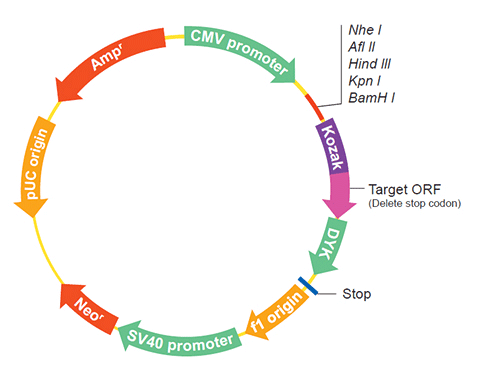| Gene Symbol | MAK16 |
| Entrez Gene ID | 696648 |
| Full Name | MAK16 homolog |
| Gene Type | protein-coding |
| Organism | Macaca mulatta(Rhesus monkey) |
HOME
ORF » Species Summary » Macaca mulatta » MAK16 cDNA ORF clone
| Gene Symbol | MAK16 |
| Entrez Gene ID | 696648 |
| Full Name | MAK16 homolog |
| Gene Type | protein-coding |
| Organism | Macaca mulatta(Rhesus monkey) |
| mRNA | Protein | Name |
|---|---|---|
| NM_001260675.1 | NP_001247604.1 | protein MAK16 homolog |

| MAK16 | XP_001086781.1 | |
| Bos taurus (cattle) | MAK16 | NP_001068638.1 |
| Rattus norvegicus (Norway rat) | Mak16 | NP_001014024.1 |
| Gallus gallus (chicken) | MAK16 | XP_004947634.1 |
| Caenorhabditis elegans (roundworm) | C16A3.6 | NP_498395.1 |
| Kluyveromyces lactis | KLLA0A04037g | XP_451178.1 |
| Eremothecium gossypii | AGOS_ADR349W | NP_984445.1 |
| Schizosaccharomyces pombe (fission yeast) | mak16 | NP_593145.1 |
| Magnaporthe oryzae (rice blast fungus) | MGG_17694 | XP_003719770.1 |
| Pan troglodytes (chimpanzee) | MAK16 | XP_001169206.1 |
| Danio rerio (zebrafish) | mak16 | NP_775346.1 |
| Xenopus tropicalis (tropical clawed frog) | mak16 | NP_988927.1 |
| Anopheles gambiae (African malaria mosquito) | AgaP_AGAP000514 | XP_310578.5 |
| Neurospora crassa | NCU04150 | XP_961306.1 |
| Homo sapiens (human) | MAK16 | NP_115898.2 |
| Canis lupus familiaris (dog) | MAK16 | XP_532811.3 |
| Mus musculus (house mouse) | Mak16 | NP_080729.1 |
| Saccharomyces cerevisiae (baker's yeast) | MAK16 | NP_009377.2 |
| Arabidopsis thaliana (thale cress) | AT1G23280 | NP_173742.1 |

Genome sequencing and comparison of two nonhuman primate animal models, the cynomolgus and Chinese rhesus macaques.
Yan G, Zhang G, Fang X, Zhang Y, Li C, Ling F, Cooper DN, Li Q, Li Y, van Gool AJ, Du H, Chen J, Chen R, Zhang P, Huang Z, Thompson JR, Meng Y, Bai Y, Wang J, Zhuo M, Wang T, Huang Y, Wei L, Li J, Wang Z, Hu H, Yang P, Le L, Stenson PD, Li B, Liu X, Ball EV, An N, Huang Q, Zhang Y, Fan W, Zhang X, Li Y, Wang W, Katze MG, Su B, Nielsen R, Yang H, Wang J, Wang X, Wang J
Nature biotechnology29(11)1019-23(2011 Oct)
GeneRIFs: Gene References Into Functions What's a GeneRIF?
The following MAK16 gene cDNA ORF clone sequences were retrieved from the NCBI Reference Sequence Database (RefSeq). These sequences represent the protein coding region of the MAK16 cDNA ORF which is encoded by the open reading frame (ORF) sequence. ORF sequences can be delivered in our standard vector, pcDNA3.1+/C-(K)DYK or the vector of your choice as an expression/transfection-ready ORF clone. Not the clone you want? Click here to find your clone.
| CloneID | OMb02688 | |
| Clone ID Related Accession (Same CDS sequence) | NM_001260675.1 | |
| Accession Version | NM_001260675.1 Latest version! | Documents for ORF clone product in default vector |
| Sequence Information | ORF Nucleotide Sequence (Length: 903bp) Protein sequence SNP |
|
| Vector | pcDNA3.1-C-(k)DYK or customized vector |  User Manual User Manual |
| Clone information | Clone Map |  MSDS MSDS |
| Tag on pcDNA3.1+/C-(K)DYK | C terminal DYKDDDDK tags | |
| ORF Insert Method | CloneEZ™ Seamless cloning technology | |
| Insert Structure | linear | |
| Update Date | 2019-04-27 | |
| Organism | Macaca mulatta(Rhesus monkey) | |
| Product | protein MAK16 homolog | |
| Comment | Comment: PROVISIONAL REFSEQ: This record has not yet been subject to final NCBI review. The reference sequence was derived from JV045719.1. On May 10, 2012 this sequence version replaced XM_001086781.2. ##Evidence-Data-START## Transcript exon combination :: JV045719.1 [ECO:0000332] RNAseq introns :: single sample supports all introns SAMEA4688315, SAMEA4688316 [ECO:0000348] ##Evidence-Data-END## | |
1 | ATGCAGTCGG ATGATGTTAT CTGGGATACA CTAGGAAACA AGCAATTTTG TTCCTTCAAA |
The stop codons will be deleted if pcDNA3.1+/C-(K)DYK vector is selected.
| RefSeq | NP_001247604.1 |
| CDS | 39..941 |
| Translation |

Target ORF information:
Target ORF information:
|
 NM_001260675.1 NM_001260675.1 |

1 | ATGCAGTCGG ATGATGTTAT CTGGGATACA CTAGGAAACA AGCAATTTTG TTCCTTCAAA |
The stop codons will be deleted if pcDNA3.1+/C-(K)DYK vector is selected.
Genome sequencing and comparison of two nonhuman primate animal models, the cynomolgus and Chinese rhesus macaques. |